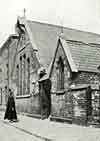 Nottingham Nottingham
St Augustine’s Mission Church
History
St Augustine’s mission church was erected in 1870 on Launder street, The Meadows, as a mission by St Saviour’s Church intended to serve the western part of the parish. At this time the open meadow land was being developed for housing, predominantly two-storey terraces and industrial premises.
The brick mission house was the work of Robert Evans of Evans & Jolley, a Nottingham architectural practice. A detailed description of the building was provided by the Nottinghamshire Guardian in a report on its opening on 30 November 1870:
'The building consists of an entrance porch ; a large room, 63ft. by 23ft.; a class-room, 18ft. by 18ft, with lavatories and usual offices for schools. The large room will accommodate 200 people, and it is intended to have divine service in it every Sunday, as far as circumstances will allow. At the east end of the room there is a recess for a communion table, which can be shut off by means of doors during school hours. The reference to school hours makes it necessary for us to explain that it is intended to use the building as an elementary school as well as a mission-house…'
Until 1882 the clergy of St Saviour’s had charge of the mission but a grant of £200 from the Nottingham Spiritual Aid and Church Extension Society provided a stipend for a curate and the ecclesiastical district of St Augustine was created with a population of 9,000. The Rev E. P. Doudney, curate of Old Radford, took on the role in August 1882 and over the next few years organised a wide range of activities: the Adult Temperance Society; the Band of Hope, day school district visiting work, sewing meetings, mothers’ meetings, teachers’ classes, communicants’ class, cottage meetings, institute, and prayer meetings.
By 1891 there were 230 communicants, 51 members of the mothers meeting, 380 children on the Sunday School books, and 300 members of the Band of Hope. The district was divided into 45 parts, which were attended to by 45 visitors.
Within a few years the size of the mission church became a problem. A note in St Saviour’s parish magazine in the mid-1880s states that the ‘mission building was no longer large enough to accommodate the congregation, and the process of planning to build a more permanent church was to commence’. This led to the construction of a stone church on the corner of St Augustine’s Street and Kirk White Street, a short distance from the mission building. It was called St George’s church to avoid confusion with two existing churches dedicated to St Augustine, one in New Basford and the other a Roman Catholic church on Woodborough Road. The foundation stone was laid on 1 July 1887, the nave was opened on 12 June 1888 and the nave and north and south aisles were consecrated on 3 November 1891; the chancel was not completed and consecrated until April 1898.
However, St Augustine’s mission continued to operate after St George’s church opened. It is not known exactly when the mission was closed, but a report on a bazaar and sale of work in June 1891 mentions the event took place at ‘St Augustine’s Church Schools, Launder Street’ and the former mission building on Launder Street is clearly labelled ‘Infant School’ on an Ordnance Survey map of 1899.
The infant school was demolished in the 1940s. St George's Priory, which provided office facilities and accommodation for priests at St George's church, was built on the site.
| 
